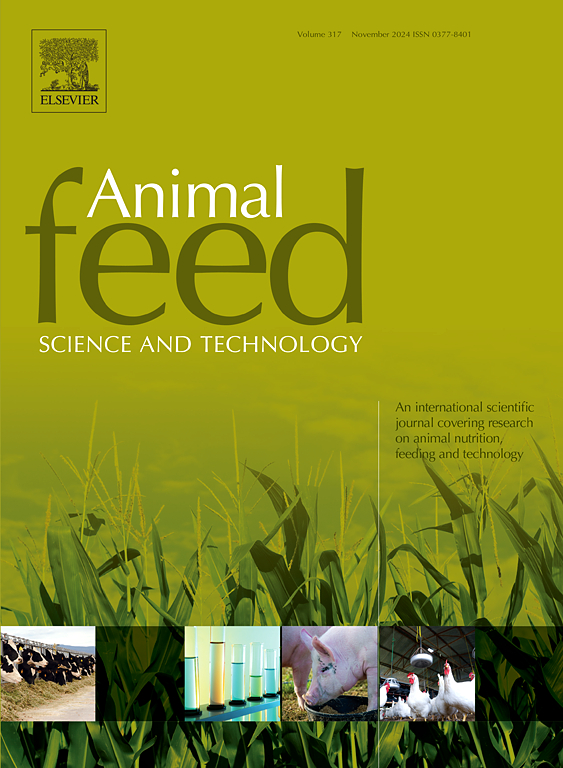饲粮中添加菠萝皮乙醇提取物可通过提高生长性能、IGF-1表达、生理生化特征、抗氧化状态和免疫应答来缓解拥挤胁迫
IF 2.5
2区 农林科学
Q1 AGRICULTURE, DAIRY & ANIMAL SCIENCE
引用次数: 0
摘要
集约化养殖系统中的拥挤胁迫降低了鱼类的生长。然而,膳食菠萝皮乙醇提取物衍生的生物活性化合物有望减少压力,增加鱼类产量。因此,在为期60天的试验中,饲粮中添加0、0.5和1 %水平的菠萝皮乙醇提取物(PPEE),以评估不同放养密度(10、15和20尾/75 L)饲养的罗氏Labeo rohita鱼种的生长性能和生理免疫反应。采用3 (PPEE水平)× 3(放养密度)因子设计,将4.15 ± 0.006 g的405只鱼种分为9组,每组3个重复。配制3种等氮(30 %粗蛋白质)、等脂(6 %)和等热量(370 kcal DE/100 g)饲粮,分别饲喂各组,每天2次。高放养密度显著(p <; 0.05)降低了鱼的末重、增重率、特定生长率、肝脏IGF-1表达、全鱼粗蛋白质、脂肪和总碳水化合物、肠道蛋白酶和脂肪酶活性、血清蛋白和总免疫球蛋白以及呼吸爆发活性(NBT),提高了饲料转化率、肝脏超氧化物歧化酶和过氧化氢酶活性。但无论放养密度如何,饲粮中添加1 % PPEE均能提高鱼的生长性能和生理免疫反应。综上所述,1 %水平的PPEE可维持集约化养殖生产。本文章由计算机程序翻译,如有差异,请以英文原文为准。
Dietary pineapple peel ethanolic extract alleviates crowding stress in Labeo rohita fingerlings with enhancement of growth performance and IGF-1 expression, physio-biochemical profile, antioxidant status and immunological responses
Crowding stress in intensified aquaculture system reduces growth of fish. However, dietary pineapple peel ethanolic extract derived bioactive compounds are expected to minimize stress with augmented fish production. Therefore, a 60-day study with dietary pineapple peel ethanolic extract (PPEE) at 0, 0.5 and 1 % levels evaluated growth performance and physio-immunological responses of Labeo rohita fingerlings reared under different stocking densities (10, 15 and 20 fish/75 L). Fish fingerlings (405 numbers) of 4.15 ± 0.006 g were distributed among nine groups in triplicate following 3 (PPEE level) × 3 (stocking density) factorial design. Three isonitrogenous (30 % crude protein), isolipidic (6 %) and isocaloric (370 kcal DE/100 g) diets were prepared and fed respective groups on satiation basis twice daily. High stocking density significantly (p < 0.05) reduced final body weight, weight gain percentage, specific growth rate, hepatic IGF-1 expression, whole-body crude protein, lipid and total carbohydrate, intestinal protease and lipase activities, serum proteins and total immunoglobulin and respiratory burst activity (NBT) and increased feed conversion ratio and hepatic superoxide dismutase and catalase activities of fish. However, irrespective of stocking density, 1 % dietary PPEE could enhance the growth performances and physio-immunological responses of fish. In conclusion, feeding of PPEE at 1 % level can sustain intensified aquaculture production.
求助全文
通过发布文献求助,成功后即可免费获取论文全文。
去求助
来源期刊

Animal Feed Science and Technology
农林科学-奶制品与动物科学
CiteScore
6.00
自引率
6.20%
发文量
266
审稿时长
3 months
期刊介绍:
Animal Feed Science and Technology is a unique journal publishing scientific papers of international interest focusing on animal feeds and their feeding.
Papers describing research on feed for ruminants and non-ruminants, including poultry, horses, companion animals and aquatic animals, are welcome.
The journal covers the following areas:
Nutritive value of feeds (e.g., assessment, improvement)
Methods of conserving and processing feeds that affect their nutritional value
Agronomic and climatic factors influencing the nutritive value of feeds
Utilization of feeds and the improvement of such
Metabolic, production, reproduction and health responses, as well as potential environmental impacts, of diet inputs and feed technologies (e.g., feeds, feed additives, feed components, mycotoxins)
Mathematical models relating directly to animal-feed interactions
Analytical and experimental methods for feed evaluation
Environmental impacts of feed technologies in animal production.
 求助内容:
求助内容: 应助结果提醒方式:
应助结果提醒方式:


